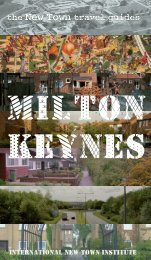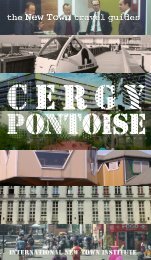You also want an ePaper? Increase the reach of your titles
YUMPU automatically turns print PDFs into web optimized ePapers that Google loves.
4 | the <strong>Alamar</strong> travel guide<br />
Chapter I:<br />
Tracing the roots<br />
of <strong>Alamar</strong><br />
<strong>Alamar</strong> is one of those new towns which look remarkably familiar at first glance. An<br />
abundance of standardized walk-up flats, modernist social housing of 5-6 storeys of a<br />
similar kind that Western European New Towns excelled in during the 50s and 60s.<br />
Organized in neighborhood units, each with their set of shops, schools and services.<br />
A lot of open, green spaces in between and ample provision for cars and traffic.<br />
But no matter how familiar this cityscape looks: this is Cuba and everything is<br />
different from what it looks like. To start with: this new town was not built in the 50s<br />
but in the 70s, in a quite extraordinary way, completely different than its European<br />
family members. Even if they share the same DNA, <strong>Alamar</strong> is not only shaped by the<br />
modernist canon of postwar new towns, but just as much by the revolutionary ethos<br />
of Cuba after the triumph of the revolution in 1959 and it even bears the marks of the<br />
prerevolutionary period under the regime of President Fulgencio Batista. 1 At second<br />
glance, this peculiar mix makes up the unique character of <strong>Alamar</strong>, new town ‘at the<br />
sea’.<br />
Havana derives its popularity as a tourist<br />
destination for a large part from the fact that<br />
the city remains practically unchanged from<br />
what it looked like 60 years ago. The old inner<br />
city, Habana Vieja, shows the same colonial<br />
structure and beautiful buildings, albeit ever<br />
more crumbling, than it did in 1959. Vedado, the<br />
urban extension dating back from the 1850s still<br />
showcases the impressive art deco architecture<br />
gems and the modernist masterpieces from the<br />
fifties in an original state that is unique in the<br />
world. But even though the formal appearance<br />
of the city is basically unchanged, the use and<br />
atmosphere of these urban areas is nothing like<br />
it used to be.<br />
Obispo Street in Habana Vieja, 1952<br />
(source: bestcubaguide.com/<br />
beautiful-1960s-old-havana-photos-archive/)<br />
Sodom and Gomorra<br />
In the fifties, Havana was an international,<br />
hustling and bustling metropolis of the kind<br />
that Latin American capitals usually were: with<br />
1. Fulgencio Batista was President of Cuba (1940–1944), Prime<br />
Minister of Cuba (1952–1952), and again President of Cuba<br />
(1955–1959).




